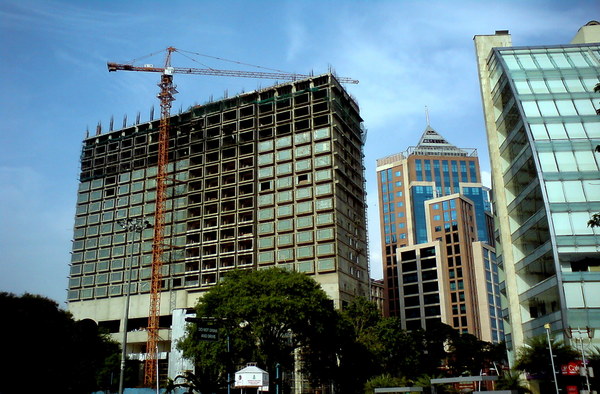On 7 April 2015, the Union Cabinet approved amendments to the Real Estate (Regulation and Development) Bill, 2013. According to a release from the Press Information Bureau, the recommendations of the Standing Committee of Parliament on Urban Development and suggestions of various stakeholders (consumer organisations, industry associations, academia, experts etc.) have also been included after extensive consultations.
The current status of the Bill
The Bill was introduced in the Rajya Sabha in August 2013. It was then referred to the Parliamentary Standing Committee on Urban Development, which submitted its report in February 2014. The Bill has not been discussed in Parliament as yet, and is currently pending in Rajya Sabha.

An under-construction project in Bangalore. Illustrative picture; Courtesy: Citizen Matters
Key features of the Bill
The Real Estate (Regulation and Development) Bill regulates transactions between buyers and promoters (sellers) of residential real estate projects. It establishes state-level regulatory authorities called Real Estate Regulatory Authorities (RERAs) in order to do so.
Residential real estate projects, with some exceptions, need to be registered with RERAs, and their details must be uploaded on the website of the RERA. This implies that promoters cannot book or offer these projects for sale without registering them with RERAs.
Real estate agents dealing in these projects also need to register with RERAs. The Bill also establishes state level appellate tribunals called Real Estate Appellate Tribunals. Decisions of RERAs can be challenged before these tribunals.
The Bill outlines the duties of promoters, buyers, and real estate agents. For example, the Bill requires that promoters keep 70 percent of the amount collected from buyers for a project, in a separate bank account. This amount must only be used for construction of that project.
The state government, however, can alter this amount to less than 70 percent. The Bill also provides for penalties for the breach of certain provisions in the legislation.
Issues to consider
To understand some of the key issues of contention in the original Bill, one must note the following:
(i) Certain states have already enacted laws to regulate real estate;
(ii) Commercial real estate has not been included within the ambit of the Bill;
(iii) Certain smaller-sized projects have not been covered under the Bill; and
(iv) 70 percent of the amount collected from buyers is required to be kept in an escrow account.
To elaborate, certain states such as West Bengal and Maharashtra have already enacted laws to regulate real estate. So, any central law on real estate that is subsequently enacted will override the provisions of state laws if they are inconsistent with the central law.
For example, while this Bill (introduced at the centre) requires that 70 percent of the amount collected from buyers be kept in a separate account and be used only for construction of that project, the Maharashtra law requires that the entire amount collected from buyers be used only for the purposes collected.
Secondly, while the Bill seeks to regulate residential real estate, commercial real estate has been excluded from its ambit. The Standing Committee has also pointed out that commercial and industrial real estate should be regulated by the Bill.
Thirdly, registration with RERAs is not required for projects that: (i) cover less than 1000 square metres, or (ii) entail the construction of less than 12 apartments or (iii) entail renovation/repair/re-development without re-allotment or marketing of the project.
The Standing Committee has pointed out that the exclusion of projects, smaller than 1,000 square meters or 12 apartments, from the purview of RERAs could lead to the exclusion of a number of small housing projects. Instead, it has suggested that only projects that are smaller than 100 square meters or three apartments need not register with the RERA.
Finally, the Bill mandates that 70 percent of the amount collected from buyers of a project be used only for construction of that project. Typically, the project cost of a real estate project includes the cost of land and the cost of construction. In certain cases, the cost of construction could be less than 70 percent and the cost of land more than 30 percent of the total amount collected. This implies that part of the funds collected could remain unutilised, necessitating some financing from other sources. Consequently, this could raise the project cost.
Among other things, the Standing Committee also suggested that all real estate agents be registered with RERAs and that a new provision be inserted to allow RERAs to give directions to state governments to establish a single window system for providing clearances for projects. Additionally, a time limit should be specified for state and local authorities to issue completion certificates for projects.
Changes to the Bill approved by Cabinet
A comprehensive list of amendments is not in the public domain yet. However, a press release of the government, published by the Press Information Bureau, indicates the following changes have been made.
(i) The application of the Bill has been extended to cover commercial real estate, in addition to residential real estate; and
(ii) The amount to be compulsorily kept in an escrow account has been reduced from 70 percent of the amount collected from buyers to 50 percent. This could even be a lesser percentage as notified by the appropriate government.























